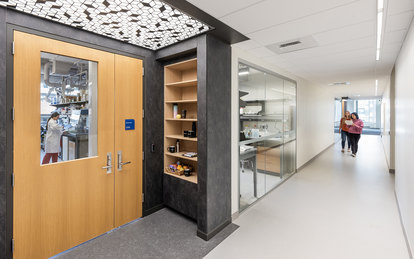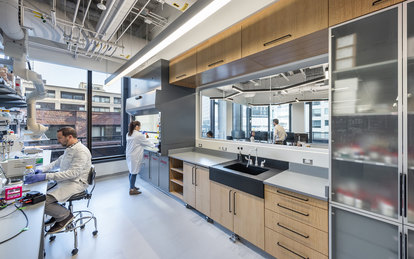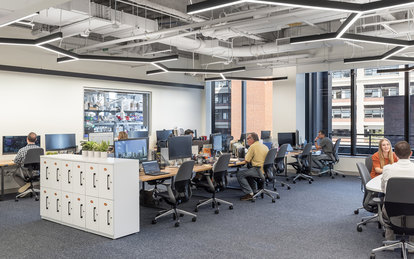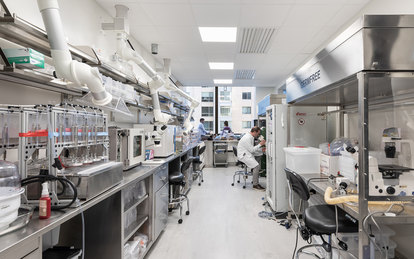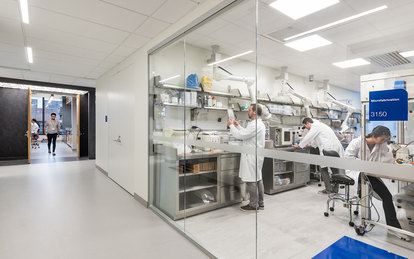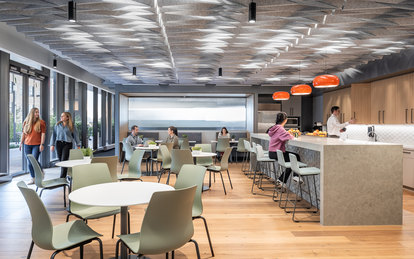The Wyss Institute for Biologically Inspired Engineering, New Research Facility
Part idea incubator, part lab, part office, the new Wyss Institute headquarters takes the agile research workplace to a new level, with a design well-suited to a dynamic roster of projects.
Client
The Wyss Institute for Biologically Inspired Engineering
Location
Boston, Massachusetts
Markets/Services
Architecture, Corporate Interiors, Corporate Research & Development, Interiors, Lab Planning, Science & Technology, Corporate & Commercial
Size
107,000 sf
Established at Harvard University in 2009, The Wyss Institute for Biologically Inspired Engineering fosters biologically-inspired research and engineering that bridges the gap between academia and industry, focused on discovering environmental and healthcare solutions that can be translated into commercial products and technologies. The Institute hosts various research projects and teams at any given time, as their discoveries are constantly evolving. After more than a decade leasing space near Harvard Medical School, the Institute is ready for its first purpose-built facility.
The new Wyss Headquarters serves both Wyss staff and the diverse research projects it supports. It enables the Wyss to fulfill its goal of transitioning from a traditional academic environment to an agile modern ecosystem of neighborhoods designed to spark inter-disciplinary collaboration. The design also prioritizes storytelling, showcasing the exciting nature of the Institute’s work for donors and dignitaries. The headquarters occupies three floors of a 14-story shell/core building in an up-and-coming biotech cluster in Boston’s Fenway district.

Booth seating of various sizes—a preferred setting for casual meetings and brainstorming sessions at the Wyss—is scattered throughout the neighborhoods.
Inspired by cellular nodes and networks, the space is organized in an energetic pattern of connectivity. From the main entrance on the middle floor, corridors and a communicating stair link the Institute’s neighborhoods, each with a mix of laboratories, lab support, open office workstations and collaborative areas.
Open Labs are designed for adaptability to both foster and respond to the evolution of research that is inherent in the Wyss process. Strategically placed windows connect the labs to non-lab spaces linking lab activity to a visitor's journey through the Institute and encouraging research collaboration. Groups co-locate within their neighborhood zone, but also benefit from circulation patterns and several shared outdoor spaces that encourage cross-pollination and interdisciplinary teamwork. Booth seating of various sizes—a preferred setting for casual meetings and brainstorming sessions at the Wyss—is scattered throughout the neighborhoods.
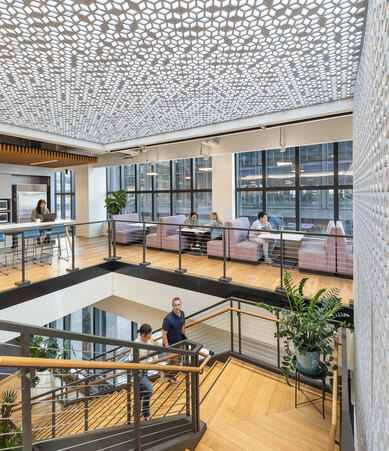
Responding to the Institute’s focus on biologically inspired engineering, the architecture of systems found in nature serves as a cohesive design element, represented by wave patterns and interlocking geodesic forms on walls, ceilings and fixtures.
Responding to the Institute’s focus on biologically inspired engineering, the architecture of systems found in nature serves as a cohesive design element, represented by wave patterns and interlocking geodesic forms on walls, ceilings and fixtures. Wood and other natural tones give a nod to Wyss’s roots in academia with the sophisticated application befitting a modern workplace. Textures and patterns, rather than bright pops of color, add visual interest and complement the base building’s urban contemporary style. The overall effect is a gallery-like setting that emphasizes photography and multi-media displays of the Institute’s work.
